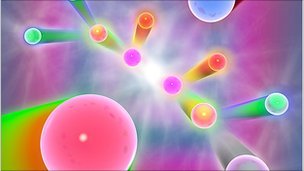
Researchers at the Large Hadron Collider (LHC) have detected one of the rarest particle decays seen in Nature.
The finding deals a significant blow to the theory of physics known as supersymmetry.
Many researchers had hoped the LHC would have confirmed this by now.
Supersymmetry, or SUSY, has gained popularity as a way to explain some of the inconsistencies in the traditional theory of subatomic physics known as the Standard Model.
The new observation, reported at the Hadron Collider Physics conference in Kyoto, is not consistent with many of the most likely models of SUSY.
Prof Chris Parkes, who is the spokesperson for the UK Participation in the LHCb experiment, said: “Supersymmetry may not be dead but these latest results have certainly put it into hospital.”
Supersymmetry theorizes the existence of more massive versions of particles that have already been detected.

Their existence would help explain why galaxies appear to rotate faster than the Standard Model would suggest. Physicists have speculated that as well as the particles we know about, galaxies contain invisible, undetected dark matter made up of super particles. The galaxies therefore contain more mass than we can detect and so spin faster.
Researchers at the LHCb detector have dealt a serious blow to this idea. They have measured the decay between a particle known as a Bs Meson into two particles known as muons. It is the first time that this decay has been observed and the team has calculated that for every billion times that the Bs Meson decays it only decays in this way three times.
If superparticles were to exist the decay would happen far more often. This test is one of the “golden” tests for supersymmetry and it is one that on the face of it this hugely popular theory among physicists has failed.
Prof. Val Gibson, leader of the Cambridge LHCb team, said that the new result was “putting our supersymmetry theory colleagues in a spin”.
The results are in fact completely in line with what one would expect from the Standard Model. There is already concern that the LHCb’s sister detectors might have expected to have detected superparticles by now, yet none have been found so far.
If supersymmetry is not an explanation for dark matter, then theorists will have to find alternative ideas to explain those inconsistencies in the Standard Model. So far researchers who are racing to find evidence of so called “new physics” have run into a series of dead ends.
“If new physics exists, then it is hiding very well behind the Standard Model,” commented Cambridge physicist Dr. Marc-Olivier Bettler, a member of the analysis team.
The result does not rule out the possibility that super particles exist. But according to Prof. Chris Parkes, “they are running out of places to hide”.